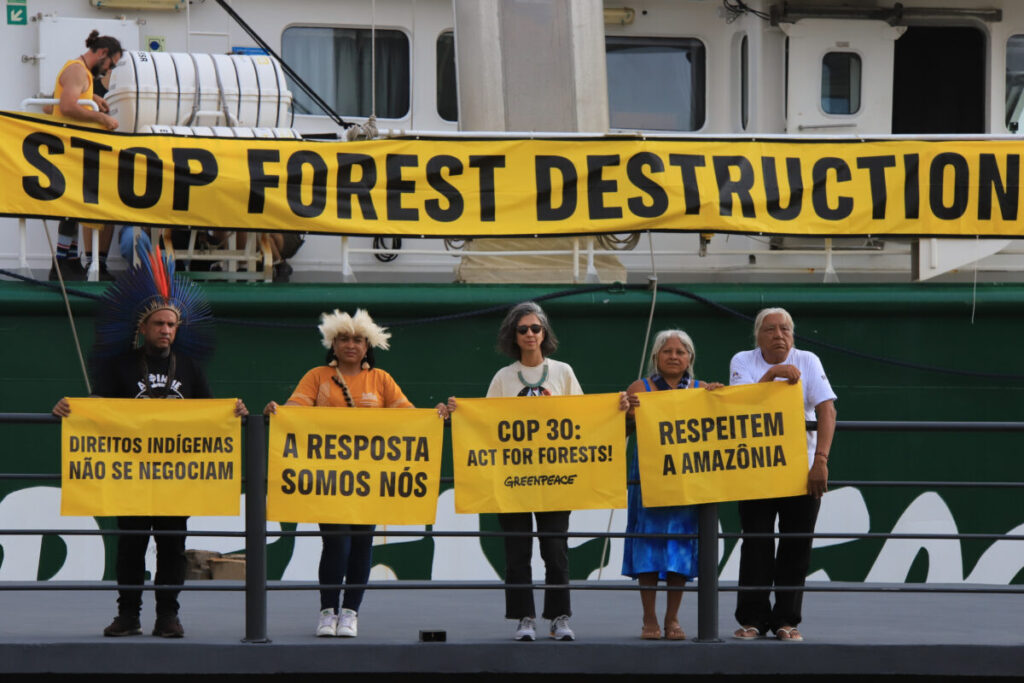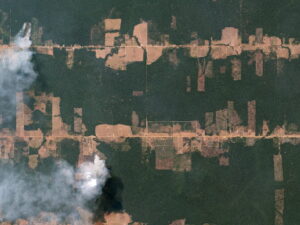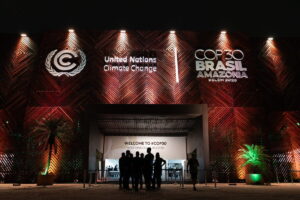Amazon Calls The World To Account At 30th UN Climate Summit In Belém
Nov 10, 2025 | Pratirodh Bureau
Indigenous leaders and activists hold signs by the Greenpeace ship Rainbow Warrior during a protest ahead of COP30 at a port in Belém (AP Photo/Paulo Santos)
- The 30th UN climate summit in Belém puts nature at the centre of climate stability since forests and ecosystems are now releasing more carbon than they store, turning natural buffers into new sources of emissions.
- Finance remains the test of credibility as the Baku-to-Belém Roadmap calls for $1.3 trillion in annual climate finance by 2035, but less than 10% of current funds reach nature-based or adaptation projects.
- India and other Global South countries are expected to continue demanding equity. With net-zero investments estimated at $10 trillion by 2070, India is pushing for fairer access to concessional finance and for nature to be valued as essential infrastructure, not an offset.
As the Amazon’s rains return after another season of drought and wildfires, the city of Belém prepares for a different kind of storm. From November 10, the world’s attention turns to this riverine capital in northern Brazil as it hosts the 30th United Nations climate summit, also known as COP30.
In the weeks before the conference, the city’s humid air has been thick with anticipation. Banners hang from colonial-era balconies, boats on the Guamá, a tributary of the Amazon River, carry the green and blue COP30 flags, and indigenous delegations arrive by canoe and motor launch.
Belém, on the edge of the world’s largest rainforest, is a fitting but uneasy stage. The Amazon, long described as the planet’s lungs, has already lost more than 17% of its forest cover. Its ecosystems are under pressure from mining, agriculture, fire, and encroachment. Holding the world’s most important climate negotiations here is a reminder that the health of forests, oceans, and biodiversity will determine the planet’s stability far more than any paragraph agreed in a negotiation room.
Forest as a climate ledger
The UNEP Emissions Gap Report 2025 shows that despite rising ambition, the world’s greenhouse gas emissions are still climbing, heating the planet further. They are now 7% higher than in 2020 and show no sign of peaking. “Implementing only current policies would lead to up to 2.8°C of warming, compared to 3.1°C last year,” the UNEP warns. It means every hectare of forest lost widens the deficit that separates global pledges from planetary reality.
The Amazon forest alone stores over 100 billion tonnes of carbon, roughly a decade’s worth of global emissions. Yet, parts of it now emit more carbon than they absorb. Its transformation from a carbon sink to a source is one of the starkest signals of Earth’s ecological distress. The forest’s decline is no longer a regional tragedy, but a global reckoning.
Belém’s hosting of COP30, the first such conference in the Amazon, signals Brazil’s intent to make forests and ecosystems central to climate diplomacy. The host country’s agenda lists forests, oceans, and biodiversity as one of six key pillars in its COP30 Action Agenda. The agenda frames the Amazon as central to that work.
Summit in shadow of reports
The State of Climate Action 2025, published by the World Resources Institute, has found that no major sector, including energy, transport, and agriculture, is yet on course to stabilize the global climate. Progress on forests and land use has been especially poor. Deforestation rates must fall by more than half this decade to meet global goals, but instead they are rising again across the tropics, the report warns.

The UNFCCC 2025 NDC Synthesis Report, which tabulates national climate plans, finds that while most nations have updated their climate pledges, the sum of those commitments still leads to higher planet-warming emissions.
The UNEP Adaptation Gap Report 2025 adds another layer to this grim picture. Developing countries now require around $365 billion annually to adapt to intensifying floods, heatwaves, and erratic and extreme rainfall, which is four times the level of current finance flows. Adaptation, the report notes, is slowing precisely when it should be accelerating.
At the leaders’ summit that preceded the formal talks on November 6-7, world leaders reaffirmed the Baku-to-Belém Roadmap target of scaling climate finance to at least $1.3 trillion annually by 2035. The leaders also called for faster and fairer disbursement of funds, as well as greater access for developing economies to clean energy infrastructure.
“Fossil fuels still command vast subsidies,” Guterres said in Belém on Thursday. “Too many corporations are making record profits from climate devastation, with billions spent on lobbying, deceiving the public, and obstructing progress.” A decade after the Paris Agreement was signed in 2015, the gap between promises and performance has become a test of credibility for the UN process.
Nature as infrastructure
For much of the Global South, adaptation is not an abstract concept. It is about living with disrupted monsoons, rising rivers, and shifting seasons.
In India, adaptation is now shaping urban planning, agriculture, and disaster management. Floods in Chennai, Mumbai, and Kolkata, and heat extremes in Delhi and Ahmedabad, are part of the same global pattern. The loss of mangroves, wetlands, and forest buffers makes cities more vulnerable to climate shocks. The ecological and economic losses are now inseparable.
Brazil’s COP30 Presidency has made adaptation a defining theme. “What has shifted dramatically? Extreme climate events are getting closer and closer,” said André Corrêa do Lago, Brazil’s chief negotiator for the summit. Many of these climate impacts could have been mitigated “if adaptation policies had been integrated into infrastructure planning,” he said. Corrêa do Lago’s words capture a wider recognition that nature itself, forests, rivers, and coastlines, is the first line of defence against a destabilising climate.
In Belém, indigenous and local communities, often described as the “guardians of biodiversity,” will be present in unprecedented numbers. Over 3,000 representatives are expected to share knowledge of forest stewardship, water management and traditional conservation practices. Their presence signals a shift in global climate politics, from abstract negotiations to lived resilience among communities and ecosystems.
Price of protection
Nature can no longer be treated as an unpaid ally. Protecting and restoring ecosystems requires funding that reflects their true worth. The Baku-to-Belém Roadmap, unveiled prior to the summit, proposes $1.3 trillion per year in climate finance by 2035, with $300 billion earmarked for transfers from wealthy nations to emerging economies.
But the distance between promise and practice remains vast. Nature-based solutions receive less than 10% of total climate funding. Adaptation finance, although critical, has seen barely any increase. Even where funds exist, bureaucratic hurdles slow disbursement.

“Instead of arguing for $1.3 trillion, the roadmap could have chosen to focus on using the agreed $300 billion effectively and efficiently by leveraging available concessional finance to crowd in and direct private finance,” said Dhruba Purkayastha, advisor, Observer Research Foundation. “With this roadmap in hand, COP30 must pivot from plans on paper to investment at scale,” said Melanie Robinson, global director of climate, economics, and finance, World Resources Institute. “The roadmap shows how to reach $1.3 trillion; now the world must deliver.”
India’s experience underlines the challenge. The Council on Energy, Environment and Water (CEEW) estimates that India will need about $10 trillion in investments by 2070 to achieve net-zero emissions. Without large-scale concessional finance, transitions risk being uneven and exclusionary.
COP30 also unfolds in an era of shifting geopolitical alliances. The return of Donald Trump to the White House and his decision to once again withdraw the US from the Paris Agreement have unsettled global cooperation. Trump’s repeated claim that the accord “punishes the U.S.” has emboldened fossil-fuel lobbies and eroded trust in multilateral progress.
With Washington’s retreat, others are repositioning. The European Union, China, Brazil, and India are forming new coalitions that link trade, climate, and technology. India’s G20 leadership and its One Sun One World One Grid initiative aim to bridge the divide between developed and developing economies. In Belém, India is expected to push for climate finance that rewards ecosystem preservation and resilience, not just carbon reduction.
India’s diplomatic footprint
India arrives in Belém with both progress and paradox. Its renewable energy capacity has crossed 200 GW, and its per capita emissions remain less than half the global average. Yet, environmental stresses continue to mount. Himalayan glaciers are retreating faster than expected, the Indo-Gangetic plains remain among the world’s most polluted, and forest loss persists despite ambitious reforestation targets. India’s new National Adaptation Plan, expected to be released at Belém, will focus on water security, agriculture, and climate-resilient cities.
Diplomatically, India is likely to champion a stronger link between finance and nature, arguing that funding must reflect the value of ecosystems and community-led conservation. This narrative of ecological equity resonates across the Global South, uniting nations facing rising costs of both adaptation and development.
The multilateral process itself is under strain. The UNEP Emissions Gap Report 2025 warns that time is short and the cost of delay grows steeper each year. The United Nations Framework Convention on Climate Change statement concedes that, while directionally positive, global efforts remain far too slow.
For developing countries, the issue is now one of trust. It remains to be seen whether the international system can still deliver fair outcomes when domestic politics in major economies are shifting so dramatically.
In the Amazon, those questions hang in the damp air. The forest that absorbs carbon and shapes rainfall is also a measure of humanity’s collective will. If Belém succeeds in linking ecological integrity with economic logic by valuing forests and biodiversity not as offsets but as essentials, it could mark a turning point in climate governance. If not, the summit risks becoming another reminder that while the planet’s natural systems know no borders, its politics still do, critically harming the world’s health.
(Published under Creative Commons from Mongabay India)
